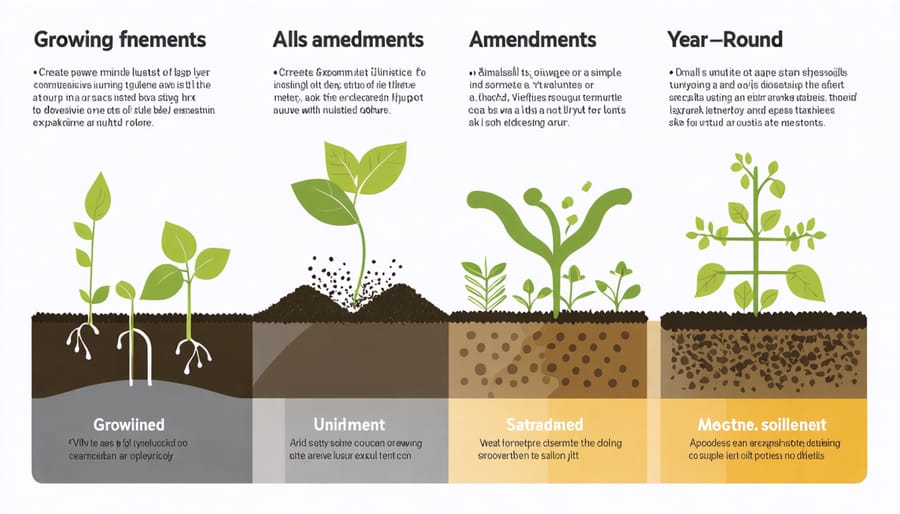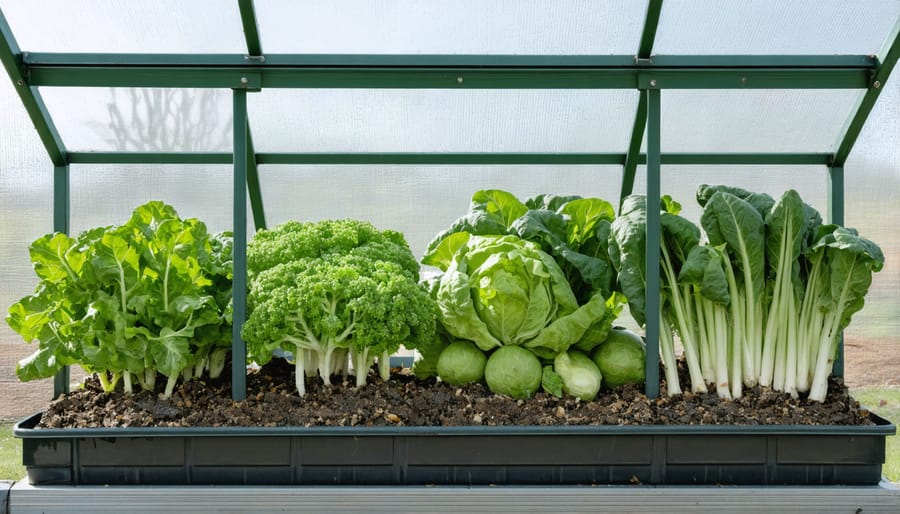Transform your backyard into a year-round oasis by mastering climate-resilient gardening practices that keep your garden thriving through every season. Plan successive plantings using cold frames and row covers for winter harvests, while maintaining summer crops in raised beds that maximize sun exposure. Install automated irrigation systems with moisture sensors to regulate water needs across seasonal changes, and create microclimates using strategic windbreaks and thermal mass structures. By combining these techniques with careful crop selection – from frost-hardy kale to heat-loving tomatoes – your garden becomes a continuous source of fresh produce, regardless of outside temperatures or weather patterns.
Deep-rooted perennials anchor the garden’s foundation, while quick-growing annuals fill seasonal gaps, creating a dynamic ecosystem that adapts to nature’s rhythms. This integrated approach not only ensures year-round harvests but also builds soil health and biodiversity, making your garden more resilient to climate fluctuations and extreme weather events. With proper planning and the right tools, four-season gardening transforms from an ambitious goal into an achievable reality for any dedicated gardener.
Planning Your Climate-Resilient Year-Round Garden
Site Assessment and Microclimate Creation
Before diving into four-season gardening, take time to evaluate your garden space and create favorable microclimates. Start by observing how sunlight moves across your property throughout the day and seasons. South-facing areas typically receive the most sunlight and warmth, making them ideal for winter growing.
Note existing structures like walls, fences, or buildings that can serve as windbreaks and heat sinks. These features store warmth during the day and release it at night, protecting nearby plants. Consider adding strategic elements like trellises or hedges to create additional sheltered growing spaces.
Assess your soil conditions and drainage patterns, as proper soil management is crucial for year-round growing. Look for naturally protected spots that could become “micro-gardens” – areas between buildings, against walls, or in the lee of existing landscaping.
To enhance protection, incorporate season extenders like cold frames, row covers, or hoop houses. These structures create controlled environments where plants can thrive despite challenging weather. Remember that even small spaces can become productive year-round gardens with thoughtful planning and microclimate manipulation.
Soil Preparation for Year-Round Success
Success in four-season gardening starts with building healthy soil that can support plants throughout the year. Start by conducting a soil test in early spring to understand your soil’s composition and pH levels. This valuable information will guide your amendment choices.
Add organic matter consistently throughout the year – compost, well-rotted manure, and leaf mold are excellent options. Layer these materials 2-3 inches deep and work them into the top 6-8 inches of soil. This practice improves soil structure, enhances water retention, and provides essential nutrients for your plants.
Consider using cover crops between growing seasons to protect and enrich your soil naturally. Winter rye and clover are particularly effective for winter protection and add valuable nitrogen when tilled under in spring. Mulching is another year-round practice that helps maintain soil moisture, regulate temperature, and suppress weeds.
Remember to avoid working wet soil, especially during spring thaw, as this can damage its structure. Instead, wait until the soil crumbles easily in your hand – a simple test that prevents long-term damage to your garden’s foundation.


Season-Specific Growing Strategies
Spring: Setting the Foundation
Spring is the cornerstone of a successful four-season garden, where thoughtful preparation sets the stage for year-round harvests. Start by conducting a soil test as soon as the ground thaws, typically in early March. This allows you to make necessary amendments before the growing season begins in earnest.
Create detailed garden maps and planting schedules, paying special attention to crop rotation from the previous year. Early spring is perfect for starting cold-hardy vegetables like peas, spinach, and lettuce directly in the ground. Meanwhile, begin warm-season crops like tomatoes and peppers indoors under grow lights, about 6-8 weeks before your last frost date.
Consider installing season extenders such as cold frames or hoop houses to protect tender seedlings from late frosts and create microclimates for early planting. These structures will prove invaluable throughout the year, especially during shoulder seasons.
Don’t forget to prepare your soil by adding compost and organic matter. A well-fed soil ecosystem in spring will support healthy plant growth all year long. This is also the ideal time to set up irrigation systems and maintain garden tools before the busy growing season kicks into high gear.
For maximum efficiency, dedicate specific areas to fast-growing spring crops that can be succeeded by summer plantings. This succession planning ensures continuous harvests and makes the most of your garden space.
Summer: Managing Heat and Drought
Summer brings unique challenges to the garden, but with proper preparation, you can keep your plants thriving through the hottest months. The key to managing heat and drought stress lies in creating a resilient garden environment.
Start by mulching generously around your plants with organic materials like straw or wood chips. This helps retain moisture, keeps roots cool, and reduces water evaporation. Consider installing shade cloth or row covers over sensitive plants during peak sun hours, especially for leafy greens and young seedlings.
Watering practices make all the difference in summer. Water deeply but less frequently to encourage deep root growth. The best time is early morning or evening when evaporation rates are lower. Installing a drip irrigation system can help deliver water directly to plant roots while conserving this precious resource.
Choose heat-tolerant varieties for summer planting, such as tomatoes, peppers, and eggplants. These Mediterranean natives actually thrive in warm weather when properly supported. Create microclimates by placing heat-sensitive plants near taller ones that can provide natural shade.
Don’t forget about container gardens – they need extra attention in summer. Move pots to shadier spots during heat waves, and consider double-potting to insulate roots. Regular monitoring of soil moisture is essential, as containers dry out faster than in-ground gardens.
Fall: Extending the Growing Season
As temperatures begin to drop, savvy gardeners know fall isn’t the end of the growing season – it’s an opportunity to extend your harvest well into the cooler months. Row covers and cold frames become your best friends during this transition, protecting tender plants from early frosts while allowing them to soak up the remaining warmth and sunlight.
Consider adding quick-growing fall crops like spinach, kale, and radishes, which thrive in cooler temperatures. These hardy vegetables often develop sweeter flavors when touched by light frost. For existing plants, use mulch generously around their bases to retain soil warmth and moisture, creating a cozy microclimate that encourages continued growth.
Now’s also the perfect time to install season extenders like hoop houses or tunnel cloches. These affordable structures can add weeks or even months to your growing season. On sunny days, remember to ventilate these covers to prevent overheating and reduce humidity that could encourage plant diseases.
Start preparing for winter by gradually hardening off plants and planning which areas you’ll protect with heavy mulch or winter cover crops. Take inventory of your successes and challenges throughout the year, noting which varieties performed best in your garden. This information will prove invaluable when planning next year’s four-season garden.
Remember to harvest regularly and store your bounty properly. Root vegetables can often remain in the ground under a thick layer of mulch, providing fresh produce well into the winter months.
Winter: Protected Growing Methods
Winter gardening doesn’t mean giving up on fresh produce – it just requires some creative protection methods! Cold frames are among the most popular options, acting like mini-greenhouses that trap heat and shield plants from harsh elements. These simple structures can be built using old windows or transparent materials and are perfect for growing hardy greens and root vegetables.
Row covers and hoop houses offer another effective solution. Made from lightweight fabric or clear plastic stretched over curved supports, they create a protective tunnel for your plants. These structures can increase temperatures by 5-10 degrees Fahrenheit, making a significant difference in plant survival rates.
For smaller spaces, cloches are ideal. These bell-shaped covers can be placed over individual plants, providing personalized protection. You can make DIY cloches using recycled plastic bottles or purchase ready-made glass or plastic versions.
Insulation is key to winter growing success. Adding a thick layer of straw or leaves around plants helps maintain soil temperature, while thermal mass elements like water-filled containers or dark-colored stones absorb heat during the day and release it at night. Multiple layers of protection work best – try combining row covers inside a greenhouse or cold frame for maximum effect.
Remember to ventilate these structures on sunny days to prevent overheating and maintain proper air circulation. With these methods in place, you can enjoy fresh harvests even in the coldest months.
Essential Tools and Structures
Season Extension Tools
Extending your growing season requires the right tools, and fortunately, there are several effective options to choose from. Cold frames are like miniature greenhouses that protect plants from frost while allowing sunlight to reach them. They’re particularly useful for starting seedlings early in spring or protecting cold-hardy vegetables during winter.
Row covers, also known as floating row covers or garden fleece, are lightweight fabric barriers that create a protective microclimate for your plants. They’re versatile and can be laid directly on plants or supported by hoops. These covers not only protect against cold but also shield plants from pests and harsh winds.
High tunnels and hoop houses offer larger-scale protection and can extend your growing season by several weeks on either end. They’re essentially unheated greenhouses that rely on solar energy to warm the soil and air around your plants. Many gardeners use these structures to grow tomatoes earlier in spring or keep greens producing well into winter.
For smaller spaces, cloche covers provide individual plant protection. These bell-shaped covers, traditionally made of glass but now often crafted from plastic, work like mini greenhouses for single plants or small clusters. They’re perfect for protecting tender seedlings or extending the harvest of cold-sensitive crops.
Remember to ventilate these structures on sunny days to prevent overheating and maintain healthy air circulation. With proper management, these season extension tools can help you maintain a productive garden year-round.

Climate Control Systems
Maintaining consistent growing conditions throughout the year requires reliable climate control systems. A well-designed irrigation system forms the foundation of year-round gardening success. Consider installing a drip irrigation system with programmable timers to ensure your plants receive consistent moisture, even during the busiest seasons.
Temperature monitoring is crucial for four-season growing. Digital thermometers with minimum/maximum readings help you track both daytime and nighttime temperatures, while wireless sensors can send alerts to your phone when temperatures approach critical thresholds. Many experienced gardeners recommend keeping detailed temperature logs to better understand your garden’s microclimates.
Shade cloth becomes invaluable during intense summer months, protecting sensitive plants from scorching sun. Look for shade cloth rated between 30-50% for most vegetables, while delicate greens might need up to 70% shade. Install it on adjustable frames so you can easily modify coverage as seasons change.
For winter growing, consider combining your shade cloth framework with clear plastic sheeting to create temporary cold frames or tunnel systems. This dual-purpose setup maximizes your investment while providing year-round climate control. Remember to include ventilation options – even in winter, proper airflow prevents disease and maintains healthy plant growth.
Automated systems can simplify climate control, but don’t forget to regularly check your equipment. Monthly maintenance ensures your systems continue working efficiently throughout all four seasons.
Maintaining Garden Resilience
Building a resilient garden is essential for successful year-round growing, and it starts with maintaining garden ecosystem health. The key is to think long-term and implement strategies that work together to create a robust growing environment.
Start by developing healthy soil through regular composting and crop rotation. Add organic matter each season and avoid leaving soil bare by using cover crops or mulch. This not only protects your soil but also feeds beneficial microorganisms that help your plants thrive.
Diversity is your garden’s best friend. Plant a variety of crops and incorporate companion planting to naturally deter pests and encourage beneficial insects. Include flowers like marigolds and nasturtiums throughout your beds – they’re not just pretty, they help create a balanced ecosystem.
Water management is crucial for year-round success. Install a reliable irrigation system and consider collecting rainwater. Adding organic mulch helps retain moisture and regulate soil temperature across seasons.
Build structures that can withstand various weather conditions. Choose sturdy materials for your cold frames and hoop houses, and regularly inspect them for damage. Remember to maintain proper ventilation to prevent issues with humidity and disease.
Finally, keep detailed records of what works and what doesn’t in your garden. This information becomes invaluable as you adapt your growing strategies from year to year, helping you create an increasingly resilient garden space.
Four-season gardening opens up a world of possibilities, allowing you to enjoy fresh harvests and the joy of growing throughout the entire year. By implementing the strategies we’ve discussed – from selecting cold-hardy plants to utilizing season extenders and creating protected growing spaces – you can transform your garden into a year-round food-producing paradise. Remember, successful four-season gardening isn’t about fighting nature but working with it. Start small, perhaps with a few cold frames or row covers, and gradually expand your growing calendar as you gain confidence. Every climate presents unique opportunities for year-round growing, and with proper planning and the right tools, you can join the growing community of gardeners who harvest fresh produce even in the depths of winter. Take that first step today – your future self will thank you for embarking on this rewarding journey toward year-round gardening success.




